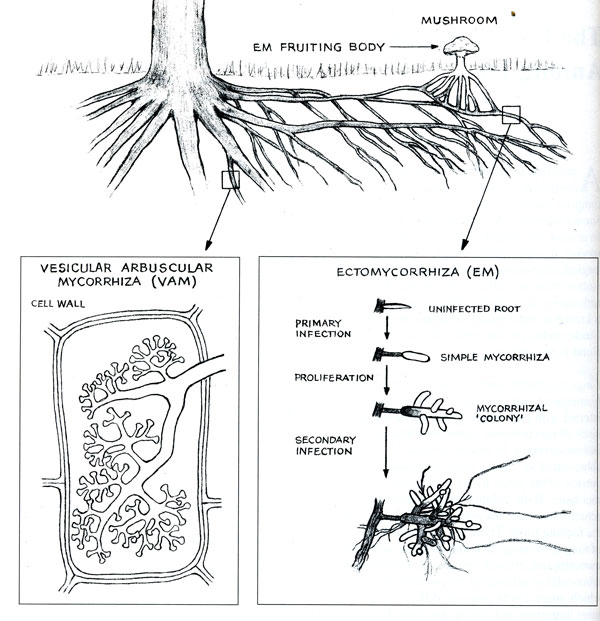Here are the main ways in which mychorrhizal associations benefit plants:
• Increasing the surface area and efficiency of the roots
• Promoting water absorption and nutrient uptake of poorly mobile soil ions such as zinc, copper, molybdenum, and potassium. Most importantly, the transfer of phosphorus that is hard for trees to absorb on their own
• Enhancing the growth of stimulatory plant hormones
• Boosting plant resistance to some pathogens, drought, and high soil temperature
• Promoting growth and yields, reducing the need for artificial fertilizers
Mychorrhizally associated plants are better able to endure environmental stress than are plants without mycorrhizae. Nutrient-poor or moisture-deficient soils also show improved plant growth and reproduction with mycorrhizal association.
Plant Root Cells: Outside and Inside
There are two primary types of mycohorrizal associations: Ectomycorrhizae (abbreviated as EM) is an interaction in which tiny mycelia of certain kinds of fungi coat the cells of the root hairs of a plant; an association in which mycelia actually penetrate into the cells of the feeding roots is known as arbuscular mycorrhizae (AM or endomycorrhizae). (This form of mycorrhizae was formerly called VAM, for Vesicular-Arbuscular Mycorrhizae.)
Mycorrhizal fungi added to a sterile planting mix can increase the absorbing surface area of pine seedlings by 80%. AM association has been known to increase the stem weight of tree seedlings by two- to 80-fold when compared to the roots of seedlings without the fungi. At the same time the root weight of the seedlings with the beneficial fungi was increased by four- to 70-fold by [V]AM.” [2] Some sources estimate that the absorption of nutrients by trees can be increased 100- to 1000-fold. [2]
Table 87
Effect of mycorhizas on the growth of pine seedlings |
Indexes of growth |
With mycorhizas |
Without mycrohizas |
Length of shoots of seedlings, cm |
35.5 |
17.5 |
Increase in length after 2 years, cm |
18.0 |
3.0 |
Length of sprouts of 2nd order, cm |
10.0 |
0.3 |
Weight of shoots part, gm |
17.0 |
3.1 |
Weight of roots, gm |
11.0 |
4.5 |
Number of leaves |
42 |
12 |
Total area of leaves, cm2 |
591.0 |
96.0 |
This chart, based on the growth of pine seedlings started in a sterile potting mix, provides a number of ways to look at the influence of sterile soil inoculated with beneficial fungi. (Note the 1958 Soviet Union spelling of mycorrhizae.) [3]

1. Dr. Mercola, Mycorrhizal Applications, Inc., PO Box 1029, Grants Pass, OR 97528 http://mycorrhizae.com/
2. “The Influence of Vesicular-Arbuscular Mycorrhizae on the Growth and Development of Eight Hardwood Tree Species” by Kormanik, Paul P.; Schultz, Richard C.; Bryan, William C., Forest Science, Volume 28, Number 3, 1 September 1982, pp. 531-539.
3. Soil Organisms, Part IV. Interaction Between Soil Microorganisms and Plants by N. A. Krasil'nikov, Academy of Sciences of the USSR Institute of Microbiology, 1958. |

